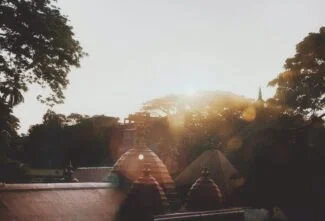~ Eashani sharma
Many of us have grown up hearing tales of gods and goddesses, their struggles, love and how they overcame obstacles. Names such as Ram and Sita, Radha and Krishna, Shiva and Parvati are commonplace in many Indian households. But did you know, goddess Parvati was not lord Shiva’s first wife? Goddess Sati was. Perhaps the tale of Shiva and Sati is less talked of because of how it came to a morbid end.
The legend behind Shakti Peethas
Sati was Prajapati Daksha’s daughter, a princess who rejected all the suitors her father thought were appropriate for her. Instead she chose Shiva, an ascetic whom her father thought to be lowly and completely wild. Daksha, enraged with his daughter’s decision, had decided to exclude the newlyweds while inviting all the gods, goddesses and royalty to a grand yagna. On learning this, Sati insisted Shiva to accompany her to the yagna but Shiva took a stand and asked Sati to back down because they were not invited. Sati was upset and against Shiva’s wishes left for her father’s place. Daksha insulted and humiliated his daughter and her husband cruelly in front of all the guests. Sati aggravated, came into her true form and after cursing Daksha of his impending doom at the hands of her husband, immolated herself. When Shiva learned of this, chaos ensued at Daksha’s palace. He had released the locks of his hair, Veerbhadra and Bhadrakali, along with eight other goddesses, started the process of destruction. Everything and all those who were involved had to pay the price. Daksha was decapitated and his army was slain. Shiva relented in the morning and brought everything back to life and order, he had replaced Daksha’s head with that of a goat’s after which Daksha had submitted to the generosity of this wild ascetic to become his devotee. But Sati was still dead. Shiva carried her body over his shoulder, unable to cope with his wife’s demise. To stop Shiva, Vihnu released sudarshan chakra to slowly cut parts off of Sati’s body. 51 parts of Sati lay around the Indian subcontinent, called Shakti Peethas. Sati or Shakti is worshipped at these 51 Shakti Peethas.
Kamakhya devi temple
Dedicated to goddess Kamakhya, Kamakhya devi temple is one of the oldest shakti peethas situated on Nilachal hill, which lies in the western part of Guwahati, Assam. According to kalika purana, the temple is built on the site where Sati and Shiva used to retire secretly to satisfy their amour, it is also the place where Sati’s yoni (genitals) fell when Shiva carried her burned body over his shoulder. Kamakhya, the tantric goddess of desire, is also called the ‘bleeding goddess’. In the month of Ashaad, the Brahmaputra near Kamakhya turns red and the goddess is said to menstruate at that time for three days. It is one of the top places to visit in Guwahati. On regular days, kamakhya temple timings are 08:00 AM to 01:00 PM and 02:30 PM to 05:30 PM.
Construction and reconstruction
The temple was first constructed by the Mlechchha dynasty. It was destroyed later by foriegn invaders (recent findings reveal it was during Hussein Shah’s invasion of the kamata kingdom in 1498, instead of kala pahar). The temple was rebuilt by the Koch dynasty. The founder of the Koch dynasty, Vishwasingha revived worship at the site, but the reconstruction was completed under the reign of his son, Nara Narayan in 1565.
Yearly celebrations
Ambubachi Mela- It is celebrated every year in june. For three days the temple is closed off to everybody as it is believed that the goddess goes through her menstruation at the time. On the fourth day, the temple gates are opened ceremonially and a big fair takes place in the temple premises.
Manasha puja- also known as Devadhwani mela, Manasha puja is celebrated at Kamakhya temple for a period of three days at the centre of the temple. Deodhani nritya is performed by the people to represent the spiritual power of gods and goddesses. Thousands of people visit Kamakhya every year to witness the dance of the Deodhas.
Durga puja- Durga puja is observed for a fortnight at Kamakhya temple, starting from krishna navami to ending on shukla navami, unlike all other temples where it is observed for 9 days.
Mahasnan- the ritualistic bath of kamakhya maa and kumari puja are the highlights of durga puja celebration at kamakhya devi temple.
Conclusion
These celebrations and the importance of Kamakhya- spiritual, archaeological, historical, social and architectural are enough to bring a variety of crowds to the temple. Being one of the top places to visit in Guwahati, it is often frequented by tourists from all over the globe. Find some time to explore rich places such as the Kamakhya temple and learn about the different cultures all across the country. Breathe in the fresh air of the hills and rejuvenate yourself while feeling enriched in the holiness of such places of worship.
Must Read: Durga Puja


